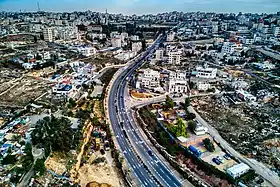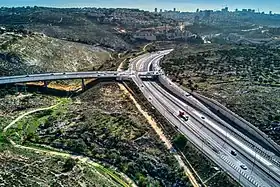 | |
 | |
| Length | 2.5 km (1.6 mi) |
|---|---|
| west end | 50/20 Interchange |
| Major junctions | Beit Hanina Road |
| east end | Junction at Highway 60 |
| Construction | |
| Completion | 2013 |


Jerusalem Road 20 is a combination of existing roads and new construction creating a continuous route between Jerusalem's Highway 50 (Begin Boulevard) and Pisgat Ze'ev via Beit Hanina.[1][2] The number "20" is a designation used by the Jerusalem Municipality. Several segments of the road follow national road 4197.[3] The cost of the project was NIS 180 million and was completed on 5 May 2013.[4]
Route
The route begins at Highway 50 (Begin Boulevard) at the new Benzion Netanyahu Interchange[5] just west of the Beit Hanina neighborhood of Jerusalem. From there the route traverses a bridge over the Atarot Stream.[6] East of the bridge, the route connects to the existing Abdul Hamid Shoman Street (Road 4197) 0.5 km before the intersection with the north-south Jerusalem Road 21. Originally a 2-lane road, Shoman Street has been upgraded as a 4 lane divided boulevard including new sidewalks and infrastructure.
At the intersection with Taha Hussein and Al-Ma'mun Streets, where Shoman Street originally veered east-southeast to become Hizma Road,[7] new lanes were constructed to create the Hizma Bypass curving 200 meters to the north.[8] This new section of Shoman Street has three traffic-light controlled intersections, at Hussein and Ma'mun Streets, at Beit Hanina Road and at Maximos Sayegh Street. Two other cross streets, Faidi al-Alami Street and al-Hilal Street, were split with pedestrian bridges to provide access across the boulevard. 200 meters east of Maximos Sayegh Street, Shoman Street rejoins the original Hizma Road (Road 4197).
Another 200 meters east, Jerusalem Road 20 ends at Highway 60 (Uzi Narkis Road). From that point, the road continues as Amihai "Gidi" Paglin Street and Sayeret Duchifat Boulevard as it enters Pisgat Zeev, leading to the Hizma security checkpoint to Route 437 and the Mateh Binyamin Region.
History
In the late 1990s, the Israel Ministry of Transport planned to construct Highway 45 from Highway 1 near Ben Gurion International Airport through the West Bank passing slightly north of Beit Horon and Beit Ur al-Fauqa to the Atarot Industrial Park in Jerusalem.[9] The current Route 443, just south of these towns, has put that plan on hold, leaving a small portion of Highway 45 between Givat Zeev and Atarot completed in 2003.[10] Furthermore, an easterly extension was envisioned which would continue from Atarot and connect with Route 437 and the Eastern Ring Road. Additionally, 45 was eventually supposed to reach the border with Jordan north of the Dead Sea.[2][11][12] The construction of the Security Wall along the right of way of Highway 45 just east of Atarot made that plan unworkable. Another east-west route would be needed to reach Route 437.
Road 20 was first approved in 2005 as a replacement to the central portion of Highway 45 pending future developments. In 2010, the planning committee of Israel's West Bank Civil Administration accepted a plan to create the route using exiting roads and new construction.[13] In 2011, the Hizma Road bypass was built. At the same time, Shoman Street was upgraded and the extension of Shoman Street to what was preliminarily called the 50/20 Interchange connecting with Begin Boulevard was begun.[14] The extension and interchange were completed in May, 2013. The interchange was officially renamed after Benzion Netanyahu, the Israeli historian.[5]
Construction of Road 20 was not without controversy. The stated official purpose of the road is to ease traffic congestion at Sha'ar Mizrach Junction of Highway 60 and Highway 1. The road provides an alternative route for residents of Beit Hanina, Shu'afat, Pisgat Zeev and Neve Yaakov via Highway 50 (Begin Boulevard) southward to central Jerusalem and northward to Route 443 to Tel Aviv. Groups such as Peace Now have stated that the plan designates occupied territory for permanent infrastructure and that the purpose of the road is to consolidate Israeli control over (North) East Jerusalem while disregarding the needs of the residents in Beit Hanina. The planning committee rejected opposition from Beit Hanina on the grounds that direct access to Begin Boulevard would benefit them and found an engineering solution in the form of a bridge to limit the footprint on West Bank land from the extension to the interchange.[13]
Junctions (west to east)
| km | Name | Type | Location | Road(s) Crossed | |
|---|---|---|---|---|---|
| 0 | מחלף בן ציון נתניהו (Benzion Netanyahu Interchange) |
Beit Hanina | (Begin Boulevard) | ||
| 0.1 | Bridge 4 lanes, 200 meters |
above Atarot Stream | |||
| Abdul Hamid Shoman St. | |||||
| 0.6 | Beit Hanina | Road 4197 west to Beit Hanina al-Balad | |||
| 0.8 | (eastbound only) | Beit Hanina | al-Sa'adeh Street | ||
| 0.9 | (westbound only) | Beit Hanina, Nof Shmu'el |
Sha'ar Shechem Street | ||
| 0.95 | (eastbound only) | Beit Hanina | |||
| 1.1 | Beit Hanina | Jerusalem Road 21 | |||
| 1.15 | (westbound only) | Beit Hanina | al-Senaabil Street | ||
| 1.22 | (eastbound only) | Beit Hanina | Umm Kulthum St. | ||
| 1.27 | (eastbound only) | Beit Hanina | al-Munzer St. | ||
| 1.3 | (westbound only) | Beit Hanina, Beit Hanina School |
al-Madaris St. | ||
| 1.45 | Beit Hanina, Rahadat Wardiya High School |
Taha Hussein St., Al-Ma'mun St. | |||
| New Abdul Hamid Shoman St. (Hizma Road Bypass) | |||||
| 1.6 | Beit Hanina | Beit Hanina Road | |||
| 1.7 | Pedestrian Bridge | Beit Hanina | Faidi al-Alami St. | ||
| 1.85 | Pedestrian Bridge | Beit Hanina | al-Hilal St. | ||
| 2.1 | Beit Hanina | Maximos Sayegh (to/from Hizma Rd.) | |||
| 2.2 | (westbound only) | Beit Hanina | |||
| 2.3 | (westbound only) | Beit Hanina | al-Akhilaas | ||
| Hizma Rd. | |||||
| 2.4 | (eastbound only) | Beit Hanina | |||
| 2.5 | Beit Hanina, Pisgat Zeev |
(Derech Uzi Narkiss), Amihai "Gidi" Paglin St., Sayeret Duchifat Blvd. to | |||
References
- ↑ "Roads Planned and Under Construstion". Jerusalem Transport Master Plan Committee. Archived from the original on 2016-10-13. Retrieved 2011-08-23.(in Hebrew)
- 1 2 "Jerusalem Transportation Network-map". Jerusalem Transport Master Plan Committee. Archived from the original on 2016-03-03. Retrieved 2011-12-30.(in Hebrew)
- ↑ "(Israel) Government Map Site". Israel Mapping Center. Retrieved 2013-05-06.(in Hebrew)
- ↑ Tovah Lazaroff (2013-05-06). "Netanyahu opens new east Jerusalem road". Jerusalem Post. Retrieved 2013-05-06.
- 1 2 "The road that will connect the north of the city to Begin open to traffic" (PDF). Jerusalem Municipality. Archived from the original (PDF) on October 22, 2020. Retrieved 2013-04-30.(in Hebrew)
- ↑ "Highways 50/20 Interchange and Highway 20". Moriah - Jerusalem Development Company Ltd. Archived from the original on 2012-06-11. Retrieved 2012-08-04.(in Hebrew)
- ↑ Street View - Shoman Street (Hizme Bypass) eastbound, from Taha Hussein/Al-Ma'mun Sts. - Hizma (old route) right of trash dumpster (Map). Google Maps. November 2011. Retrieved 2013-04-06.
- ↑ Street View - Shoman Street (Hizma Bypass) eastbound from Beit Hanina Road (Map). Google Maps. November 2011. Retrieved 2013-04-06.
- ↑ "Highway 45 (with map)". DEL Group (Engineering, Development & Infrastructure). Retrieved 2013-01-02.(in Hebrew)
- ↑ Gal Nissim (2002-04-28). "Transport Ministry Will Advance the Widening of Highway 45". 'Globes' Business Scene in Israel. Retrieved 2011-08-23.(in Hebrew)
- ↑ Shahar Hezelkorn (2007-10-31). "How The Roads in Israel Will Appear in 2030". Ynet - Yediot Acharonot. Retrieved 2013-01-02.(in Hebrew)
- ↑ "Jerusalem Transport Master Plan-2005 map". Jerusalem Transport Master Plan Committee. Archived from the original on 2012-12-18. Retrieved 2011-08-23.(in Hebrew)
- 1 2 Akiva Eldar (2011-12-02). "Israel paving road to link East Jerusalem neighborhoods to city center". Haaretz. Retrieved 2012-12-26.(in English)
- ↑ "Arterial road system planned for 2012". Jerusalem Municipality. section 4. Archived from the original on 2013-01-11. Retrieved 2012-08-04.(in Hebrew)